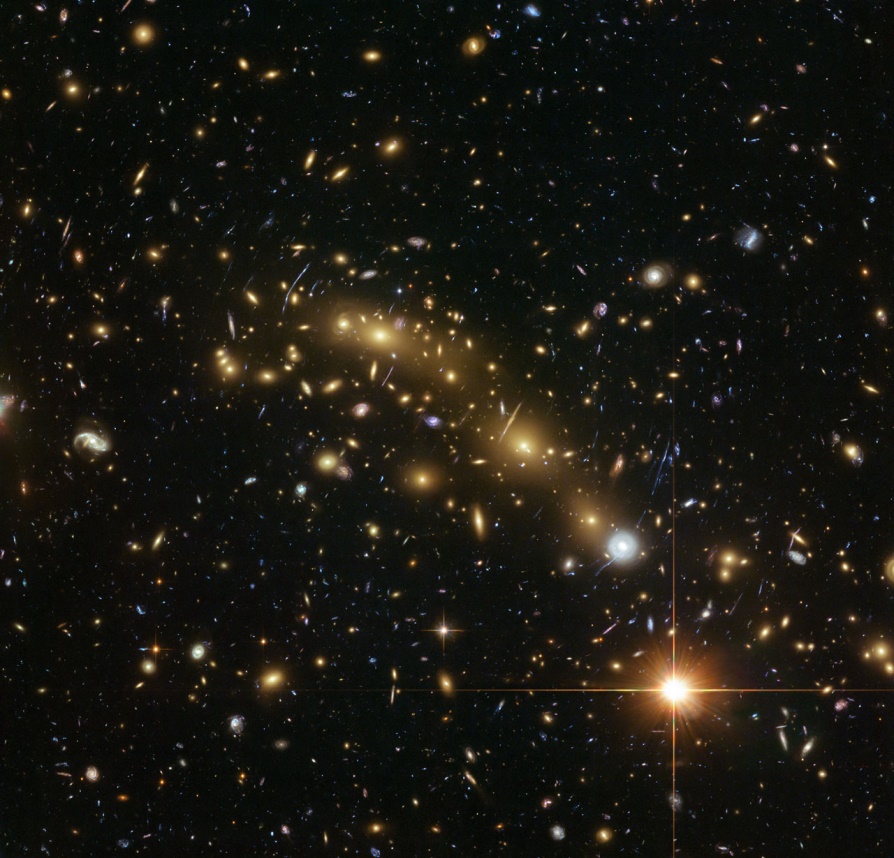Huge Galaxies' Curious Alignment Started Early

Galaxies can form pointing every which way in space, but researchers have been surprised over the years to find that the most massive ones in huge clusters lined up to match their overall clusters' direction. Now, a new study suggests that galactic giants took on that orientation as early as 10 billion years ago.
Researchers peered at 65 galaxy clusters using data from the Hubble Space Telescope. These galactic metropolises can host hundreds of thousands of individual galaxies and are located billions of light-years away from Earth. In this data, the researchers saw that the brightest galaxies were already aligned with the overall cluster when the light first left the galaxies and headed toward Earth — which was when the universe was just one-third as old as it is now, researchers said in a statement. The new study marks the earliest this effect has ever been seen.
"It's an important new piece of the puzzle, because it says that whatever caused these alignments happened early," Michael West, an astronomer at the Lowell Observatory in Arizona and lead author on the new work, said in the statement. [Celestial Photos: Hubble Space Telescope's Latest Cosmic Views]
The researchers noted in their new paper, published yesterday (June 12) in the journal Nature Astronomy, that only the brightest galaxies in galaxy clusters seemed to align with the orientation of the galaxy cluster as a whole.
"The primary factor that appears to determine whether a galaxy is aligned with its host cluster is that it must be the brightest cluster member, which suggests that there is something special about the birth and evolution of those galaxies," the researchers wrote in the paper.
The result brings researchers closer to understanding how those alignments come to be. It does so by putting a constraint on how quickly that alignment must have happened, the researchers said. One hypothesis holds that gravity slowly pulls the largest galaxies to line up with one another; another explanation suggests that galaxies grow by accumulating smaller galaxies preferentially in certain directions because of the cosmic web. This enormous network of filaments was imprinted by quantum fluctuations in the early universe.
In their paper, the researchers also suggested that the galaxies might have been aligned with surrounding matter as they started to form.
Get the Space.com Newsletter
Breaking space news, the latest updates on rocket launches, skywatching events and more!
The researchers said they hope to look at even earlier galaxy clusters to further push back the limits on the alignment effect. This will help them determine if it must have happened even faster, or to find a time when the galaxies were not yet aligned, the scientists said.
Such research with Hubble will push the limits of current telescope technology, West said. "We're trying to measure the shapes and orientations of galaxies that appear very faint and very small because of their great distances, which is challenging," he said in the statement.
Email Sarah Lewin at slewin@space.com or follow her @SarahExplains. Follow us @Spacedotcom, Facebook and Google+. Original article on Space.com.
Join our Space Forums to keep talking space on the latest missions, night sky and more! And if you have a news tip, correction or comment, let us know at: community@space.com.

Sarah Lewin started writing for Space.com in June of 2015 as a Staff Writer and became Associate Editor in 2019 . Her work has been featured by Scientific American, IEEE Spectrum, Quanta Magazine, Wired, The Scientist, Science Friday and WGBH's Inside NOVA. Sarah has an MA from NYU's Science, Health and Environmental Reporting Program and an AB in mathematics from Brown University. When not writing, reading or thinking about space, Sarah enjoys musical theatre and mathematical papercraft. She is currently Assistant News Editor at Scientific American. You can follow her on Twitter @SarahExplains.









